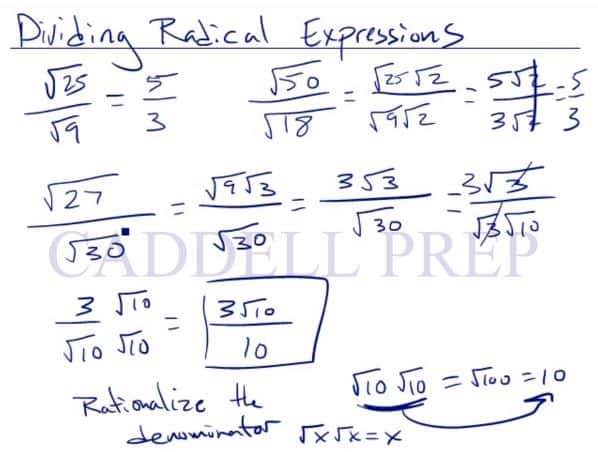In this video, we are going to divide radical expressions. After you finish this lesson, view all of our Algebra 1 lessons and practice problems.
One simple example is:
By simplifying the numerator and the denominator, we now have
A slightly more difficult problem would be:
Just like the other problem, first find perfect square factors for each expression
Simplify each expression
And the final answer is
If the expression has a radical in the denominator and a rational number in the numerator, then it is necessary to rationalize the fraction.
For example:
Multiple the denominator to both the numerator and the denominator. Like terms cancel each other out so the final answer is:
Examples of Dividing Radical Expressions
Example 1
Since the denominator has a radical, we have to rationalize the fraction.
Multiply the numerator and denominator by
Now, we have
The final answer is
Example 2
Simplify first the terms inside the radical
Then is
and
is
Now, we have
Video-Lesson Transcript
Let’s go over how to divide radical expressions.
Let’s say we have
And there’s not much to do.
But what if we have
And just like if we have
will be cancelled out.
In this case, will be cancelled out.
So our answer is
Of course, not all is going to work out like this.
Let’s look at another example.
Now, let’s break this down.
This is how far we can go as far as the radicals are concerned.
But this is not our final answer.
Because we don’t want a radical in the denominator.
But even more so, we can reduce this.
Just like this example:
Another way to look at that is:
cancels out and we’re left with
Now, let’s apply this in solving. Let’s go back
We can break this down even more into
Here, is going to cancel out.
And we have
Now, we want to rationalize the denominator.
The trick in getting rid of is to multiply the numerator and denominator by the same number.
This is our final answer
Now, let’s look at some more.
Let’s break this down
Then let’s reduce and
We’ll have
Now, we don’t want a radical in the denominator.
We have to rationalize it. So let’s multiply the numerator and denominator by .
Which we cancel and we’re left with our final answer
This is a correct way to solve it.
Any way you solve for the correct answer is a good way to do it.
Let me show you another way.
We can reduce this right off the bat.
goes into
, so this can be reduced to
Two different options to solve the same problem. We have the same answer both ways.



